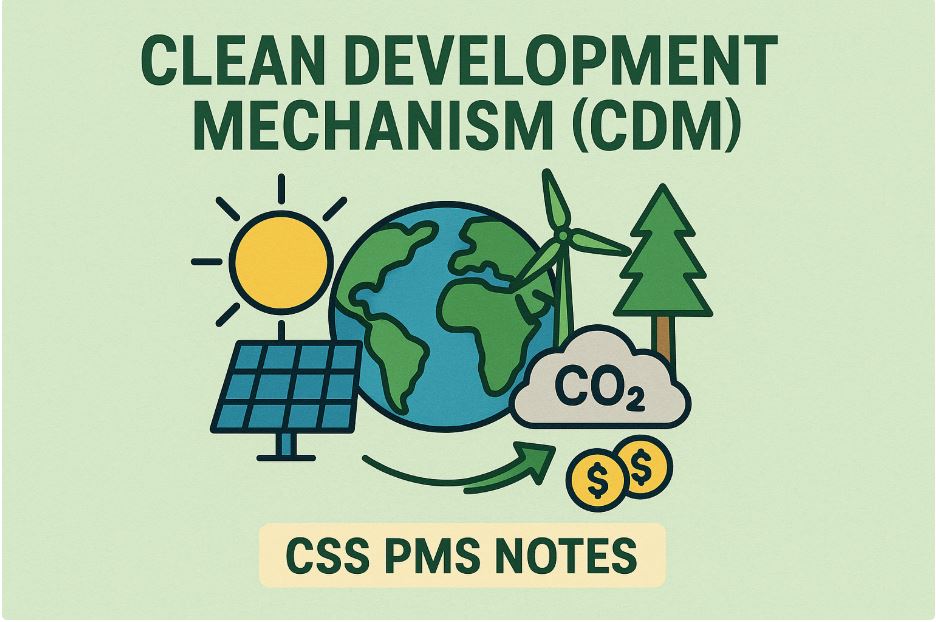Clean Development Mechanism (CDM)

A Bridge Between Development and Climate Action
Imagine earning rewards for helping the planet. That’s what the Clean Development Mechanism (CDM) does — it connects global development with the fight against climate change. It turns emission reductions into opportunities for countries and businesses, while helping the Earth heal.
What is the Clean Development Mechanism (CDM)?
Definition & Purpose
The Clean Development Mechanism (CDM) is one of the Kyoto Protocol’s flexible mechanisms established in 1997.
It allows industrialized countries (Annex I) to invest in emission-reduction projects in developing countries (non-Annex I).In return, they earn Certified Emission Reductions (CERs) — each equal to one ton of CO₂ reduced.
In simple words: a developed country funds a green project in a developing nation and gets carbon credits for helping reduce emissions.
Legal Basis (Kyoto Protocol, Article 12)
CDM is defined under Article 12 of the Kyoto Protocol.
It serves two main goals:
- Assist developing countries in achieving sustainable development.
- Help developed countries meet their greenhouse gas (GHG) reduction targets cost-effectively.
It operates under the United Nations Framework Convention on Climate Change (UNFCCC), ensuring transparency and verification at every stage.
How CDM Works: Project Cycle & Key Steps
🔍 Baseline, Additionality, Registration, Monitoring, Verification
Every CDM project goes through a series of structured steps:
| Step | Process Description |
|---|---|
| 1. Baseline Setting | Estimate how much CO₂ would be emitted without the project. |
| 2. Additionality | Prove the project would not happen without CDM support. |
| 3. Validation & Registration | Independent experts check the plan before approval by the UNFCCC. |
| 4. Monitoring | Track emissions using scientific methods. |
| 5. Verification & Certification | Auditors confirm real emission reductions. |
| 6. Issuance of CERs | The UNFCCC issues Certified Emission Reductions (CERs). |
These CERs can be sold or traded in carbon markets, turning environmental action into economic gain.
Eligibility & Host Country Requirements
For a project to qualify as a CDM project:
- The host country must be a non-Annex I party to the Kyoto Protocol.
- The project must contribute to sustainable development goals (SDGs).
- The project should follow UNFCCC-approved methodologies.
- It must show measurable and long-term benefits for emission reduction.
Common host countries include India, China, Brazil, and South Africa — nations with both growth and green potential.
Key Elements and Sectors Covered
CDM projects target different sectors that have direct impact on greenhouse gas emissions.
| Sector | Example Projects |
|---|---|
| Energy Efficiency | Efficient lighting, clean cooking stoves, energy-saving factories |
| Renewable Energy | Solar, wind, hydro, biomass energy projects |
| Waste Management | Landfill methane recovery, composting plants |
| Forestry | Afforestation and reforestation projects |
| Agriculture | Methane capture from livestock and rice paddies |
Each sector supports both emission cuts and community development.
Benefits: For Developed & Developing Countries
The Clean Development Mechanism creates a win-win situation for everyone.
For Developing Countries:
- Attracts foreign investment and technology transfer.
- Creates jobs and local income opportunities.
- Promotes renewable energy and sustainable infrastructure.
- Supports national climate action goals.
For Developed Countries:
- Provides cost-effective carbon credits (CERs).
- Helps meet Kyoto Protocol emission targets.
- Improves corporate sustainability reputation.
- Encourages global climate cooperation.
Challenges and Criticisms of CDM
Despite its success, CDM has faced some challenges:
- Complex and expensive project approval process.
- Uneven project distribution (Asia dominates, Africa lags).
- Falling CER prices in global carbon markets.
- Concerns over project additionality and real impact.
- Difficulty integrating under the Paris Agreement framework.
Still, CDM remains a cornerstone in international climate finance and sustainability policy.
CDM in the Future & Relation to Paris Agreement / Article 6
Under the Paris Agreement, the CDM concept evolves into Article 6 market mechanisms, focusing on:
- Transparency in carbon accounting.
- Global cooperation in emission trading.
- Private sector participation in green investment.
CDM’s legacy lives on — now guiding the global carbon market and net-zero transition strategies.
Conclusion
The Clean Development Mechanism (CDM) remains one of the most influential tools in global climate policy. It helps developing nations grow sustainably while giving developed countries a chance to offset their emissions responsibly. As we move into a new era of climate action under the Paris Agreement, CDM continues to inspire — proving that sustainability and development can go hand in hand.
FAQs (Frequently Asked Questions)
Q1: What is the Clean Development Mechanism (CDM)?
CDM allows developed countries to fund emission-reduction projects in developing countries and earn carbon credits.
Q2: What are Certified Emission Reductions (CERs)?
CERs are official credits, each representing one ton of CO₂ reduced through a CDM project.
Q3: How does CDM support sustainable development?
It promotes renewable energy, creates jobs, and helps developing countries reduce pollution.
Q4: Is CDM still active after the Paris Agreement?
Yes, CDM is transitioning into new carbon market models under Article 6 of the Paris Agreement.
Q5: Which sectors benefit most from CDM?
Renewable energy, waste management, and forestry sectors benefit most through technology and funding.
Q6: What is the difference between CDM and Joint Implementation (JI)?
CDM involves developed and developing countries, while JI is between two developed nations.
✅ Call to Action:
Learn more about climate solutions and sustainability on CSS PMS NOTES — your trusted source for global education and environmental insights.